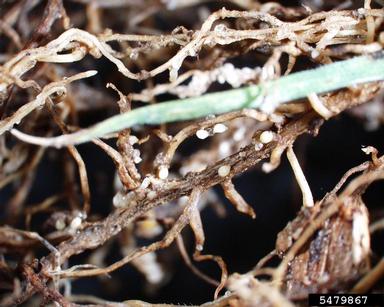Heterodera glycines
Soybean Cyst Nematode
Class: Secernetea
Order: Tylenchida
Family: Heteroderidae


Photographer: Elizabeth Bush Photographer: Kris Lambert
Source: VA Polytechnic Institute and Source: http://www.jgi.doe.gov/sequencing/why/99197.html
State University, Bugwood.org
Description
Heterodera glycines is from the family Heteroderidae and infects soybeans at the roots and create cysts there (pictured left). Females are lemon-shaped and they pass through a pale yellow stage before turning into a dark brown cyst. Males are about 1.3mm in length and resemble other Heterodera species. Second-stage larvae average 439.6 microns long (pictured right).
During years of abundant moisture and fertile soil, soybeans may produce an almost normal crop while harboring enormous numbers of nematodes, so it can remain hidden. However it also can cause "yellow dwarf" disease in soybeans which is visible to the farmers by the shortened plants and reduce chlorophyll giving them a yellow appearance; this usually means that there is a lethal population of nematodes.
Host Plant: Soybeans are the primary hosts; but can also be found on Bush Clovers (Lespedeza sp.), Beardtongues (Penstemon sp.) and String Beans (Phaseolus vulgaris).
Ecological Threat: Since the symptoms can be unnoticeable to the human eye; yield losses of about 30% of the soybean crop is possible without noticing any obvious problem until harvest. Heterodera glycines, the soybean cyst nematode (SCN), is the most devastating pathogen of soybean in the USA, causing hundreds of millions of dollars in damage annually to this valuable biological-energy crop.
Biology: Development and basic biology are similar to those of other cyst-nematodes (i.e.: golden nematode). First-stage juveniles molt to second stage within the eggs and hatch under stimulation from exudates from host roots. They invade the root and begin feeding on a group of cells. The female nematode remains at this feeding site as it develops through the vermiform juvenile stages into the swollen adult form (pictured left). The swelling of the female disrupts the tissues of the host root and the body of the nematode finally protrudes from the surface. The males leave the root and are attracted towards the female, where copulation takes place. Eggs are formed within the female and some are laid into an egg sac or "gelatinous matrix". Males may sometimes be found in the gelatinous matrix. When the female dies the body becomes a hardened protective cyst enclosing the eggs. In the absence of a host, contents of cysts may remain viable in soil for 6-8 years.
History: Heterodera glycines is the most widespread cyst nematode in the United States. It was first reported in the United States in North Carolina in 1954, but was reported in Japan in the 1880s as H. schachtii. The soybean cyst nematode is believed to have come to the U.S. from Japan with soil imported during the late 1800's to obtain nitrogen-fixing bacteria. SCN was first found in the U.S. in 1954 in North Carolina and rapidly moved to the Midwest. SCN is now present in all the major soybean growing states in the Midwest
U.S. Habitat: Anywhere that soybean plants grow
Distribution
Native Origin: Origin unsure but first reported from Japan
U.S. Present: AL, AR, DE, FL, GA, IA, IL, IN, KY, LA, MD, MN, MO, MS, NC, OH, OK, SC, TN, TX, VA, WI
Management
Management of Heterodera glycines requires the development of both long- and short-term strategies which promote soybean health and minimize nematode reproduction. Since nematicides can cause negative conomic returns for farmers; nematicides are not recommended for control of Heterodera glycines therefore other measures are to be taken.
An USDA soybean breeder, Hartwig, produced many nematode-resistant soybean varieties. Heterodera glycines is sexually reproducing and there appears to be considerable genotypic variability in field populations. Repeated use of resistant soybean cultivars has led to selection of aggressive nematode strains in many fields. Current recommendations are to rotate susceptible and resistant varieties with non-host crops (Ie: corn, peanut, cotton or grain sorghum) to have a stabilizing selection effect on the nematode, creating less aggressive nematode strains.
Damage caused by SCN tends to be greater in early than in late planted soybean since the population density declines from April to June. Yields of late-planted soybean, however, tend to be somewhat lower than those planted early. Growers can take advantage of this fact by planting the land most subject to SCN damage last. Also, reduce weeds in fields because weeds can be SCN hosts also
Text References
Huang, J.S. 1998. Mechanisms of resistance. Pp353-368 in Sharma, S.B. (ed). The Cyst Nematodes. Kluwer, Dordrecht.
Smolik, J. D., & Draper, M. A. 1998. Soybean Cyst Nematode. Cooperative Extension Service.
Internet Sources
http://plpnemweb.ucdavis.edu/nemaplex/Taxadata/G060S4.HTM
http://www.itis.gov/servlet/SingleRpt/SingleRpt?search_topic=TSN&search_value=63573
http://www.eppo.int/QUARANTINE/nematodes/Heterodera_glycines/HETDGL_ds.pdf
http://www.invasivespeciesinfo.gov/animals/scn.shtml
http://www.ces.ncsu.edu/depts/pp/notes/Soybean/soy001/soy001.htm
 Texas Invasive Species Institute
Texas Invasive Species Institute